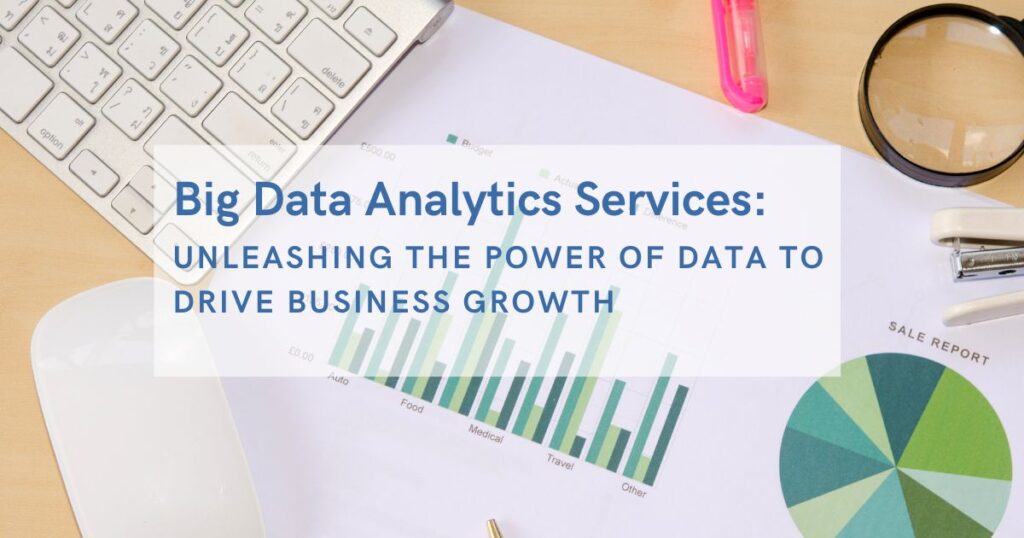In today’s data-driven world, information is the new oil. Businesses that can effectively gather, analyze, and interpret data have a significant edge over competitors. That’s where Big Data Analytics Services step in. Whether you’re running a startup or a Fortune 500 company, big data analytics has the potential to revolutionize your operations, improve decision-making, and skyrocket profits.
Let’s explore how these services work, why they matter, and how your business can harness their full power.
What Are Big Data Analytics Services?
Big Data Analytics Services involve the examination of massive and complex data sets—often too large for traditional data-processing applications. These services help businesses uncover hidden patterns, correlations, market trends, and customer preferences to make more informed decisions.
It’s not just about collecting data; it’s about making sense of the chaos and transforming it into actionable insights.
Why Are Big Data Analytics Services Important?
Let’s put it simply—knowledge is power. And big data analytics is the tool that transforms raw data into valuable knowledge.
1. Better Decision-Making
With accurate data insights, organizations can move from guesswork to informed strategy.
2. Enhanced Customer Experience
By understanding customer behaviors and preferences, companies can personalize offerings, boost engagement, and improve satisfaction.
3. Cost Efficiency
Identifying operational inefficiencies through analytics helps in saving resources and optimizing workflows.
Types of Big Data Analytics
Big data analytics isn’t a one-size-fits-all solution. Here are the major types:
1. Descriptive Analytics
This is the “what happened?” analysis. It uses historical data to provide context and explain trends.
2. Diagnostic Analytics
Here, we dive deeper to understand “why did it happen?” It identifies root causes and patterns.
3. Predictive Analytics
By leveraging machine learning, this type answers “what is likely to happen?” Perfect for forecasting trends.
4. Prescriptive Analytics
This is the futuristic advisor—suggesting actions and outcomes for “what should we do next?”
Key Components of Big Data Analytics Services
Let’s break down the moving parts behind the magic of big data analytics services:
1. Data Collection
From social media and CRM systems to IoT devices and eCommerce transactions—data is collected from multiple sources.
2. Data Storage
Technologies like Hadoop, Amazon S3, and Google BigQuery provide scalable storage for structured and unstructured data.
3. Data Processing
Using distributed processing frameworks like Apache Spark, data is cleaned, organized, and made analysis-ready.
4. Data Analysis
This is the heart of big data services. Advanced algorithms and tools (like Python, R, or SAS) are used to derive insights.
5. Data Visualization
Platforms like Tableau and Power BI help convert data into visual stories that anyone can understand.
Industries That Benefit from Big Data Analytics Services
1. Healthcare
From patient diagnostics to operational management, data analytics enhances treatment accuracy and reduces costs.
2. Finance
Real-time fraud detection, credit scoring, and risk analysis are all powered by big data.
3. Retail
Businesses analyze purchasing behaviors to predict trends and manage inventory efficiently.
4. Manufacturing
Predictive maintenance and supply chain optimization rely heavily on data insights.
5. Telecommunications
Improved customer service, network optimization, and churn analysis are key benefits here.
Top Tools and Technologies Used in Big Data Analytics
Here are some popular tools that power these services:
-
Apache Hadoop – Distributed storage and processing.
-
Apache Spark – Real-time data processing.
-
Kafka – High-throughput data streaming.
-
Power BI & Tableau – Visualization.
-
Python & R – Programming for data science.
-
NoSQL Databases – MongoDB, Cassandra, etc.
Challenges in Big Data Analytics (And How to Overcome Them)
1. Data Quality Issues
Garbage in, garbage out. Poor quality data leads to misleading insights. Ensure rigorous data cleaning and validation.
2. Talent Shortage
Data scientists and analysts are in high demand. Consider outsourcing or upskilling your internal teams.
3. Data Security & Privacy
Implement strict access controls, encryption, and compliance with laws like GDPR to safeguard data.
How to Choose the Right Big Data Analytics Service Provider
You’re ready to dive in—but who should you trust?
Checklist to Consider:
-
Proven expertise and portfolio
-
Industry-specific knowledge
-
Scalable infrastructure
-
Strong support and training
-
Security compliance certifications
Don’t just go with the biggest name—go with the best fit for your goals.
Emerging Trends in Big Data Analytics
Keep your eyes on the horizon—big data is evolving fast.
1. AI and Machine Learning Integration
AI helps automate and enhance the accuracy of analytics.
2. Edge Analytics
Instead of sending data to a central server, it’s analyzed at the edge (e.g., IoT devices) for real-time decision-making.
3. Data-as-a-Service (DaaS)
Businesses can now subscribe to data services instead of owning the infrastructure.
Benefits of Outsourcing Big Data Analytics Services
You don’t need to build a data center in your office. Here’s why outsourcing is often the smarter choice:
-
Access to skilled professionals
-
Cost savings on infrastructure
-
Faster implementation
-
Focus on core business
Real-World Example: How Netflix Uses Big Data
Ever wondered how Netflix knows what to recommend?
They use big data to track viewing behavior, preferences, location, and time spent on each title. This data fuels their recommendation engine and even influences original content production.
Big Data and the Future of Business
Big data is not a trend—it’s the new norm. Businesses that adopt analytics early and effectively are already outpacing competitors in growth and innovation.
Whether it’s predicting market trends, improving customer loyalty, or automating operations—big data analytics is your rocket fuel.
Conclusion
Big Data Analytics Services are no longer optional—they’re essential. They help organizations turn raw, unstructured data into insights that drive success. From improving customer experiences to streamlining operations and predicting market behavior, the benefits are undeniable.
In a world drowning in data, big data analytics is your lifeline. Ready to dive in?
FAQs
1. What are the main goals of big data analytics?
The main goals are to extract meaningful insights, improve decision-making, optimize operations, and drive business growth.
2. Is big data analytics only for large companies?
Not at all. Even small and medium businesses can benefit from tailored big data solutions or cloud-based services.
3. How is big data different from traditional data analysis?
Big data involves much larger, faster, and more diverse data sets, requiring advanced tools and technologies for real-time analysis.
4. What skills are needed for big data analytics?
Skills include data science, statistics, machine learning, data engineering, and proficiency in tools like Hadoop, Python, and SQL.
5. Can big data analytics help with marketing?
Absolutely! It can identify customer segments, predict trends, and personalize campaigns to improve ROI.
- Big Data Analytics Services: Unleashing the Power of Data to Drive Business Growth
- Unlock the full potential of your business with Big Data Analytics Services. Learn how advanced data analysis transforms operations, improves customer experience, and drives success across industries in this comprehensive, SEO-optimized guide.
- #BigData, #DataAnalytics, #BigDataServices, #DataScience, #PredictiveAnalytics, #BusinessIntelligence, #DigitalTransformation, #MachineLearning, #DataDriven, #TechInnovation
Related posts:
 High-Quality Biomedical Waste Incinerators & Laboratory Glassware Made in India
High-Quality Biomedical Waste Incinerators & Laboratory Glassware Made in India
 Understanding the Role of IoT in Modern Manufacturing: A Comprehensive Guide to Smart Factories and Industrial Transformation
Understanding the Role of IoT in Modern Manufacturing: A Comprehensive Guide to Smart Factories and Industrial Transformation
 Smarter Business Networks Start with a Cisco Solution Provider Partner
Smarter Business Networks Start with a Cisco Solution Provider Partner
 Best Account Management Software for All Businesses – EmizenTech
Best Account Management Software for All Businesses – EmizenTech
 Top 15 Global Website Design Companies You Can Hire in the 2025
Top 15 Global Website Design Companies You Can Hire in the 2025
 Empowering Qatari Retail Businesses with Microsoft Dynamics 365 Commerce
Empowering Qatari Retail Businesses with Microsoft Dynamics 365 Commerce
 Safety Procedures in Heavy Equipment Moving: Best Practices for Workplace Security
Safety Procedures in Heavy Equipment Moving: Best Practices for Workplace Security
 How Microinteractions Are Revolutionizing Mobile UI/UX Design in 2025
How Microinteractions Are Revolutionizing Mobile UI/UX Design in 2025







